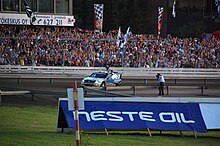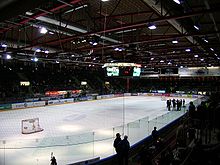Jyväskylä
Elias Lönnrot, the author of the Finnish national epic, the Kalevala, nicknamed the city "the Athens of Finland".The first part of the city's name, jyväs-, looks like the stem of an adjective *jyvänen, derived from jyvä, "grain" (compare Wiktionary).[15] Erkki Fredrikson, the curator of the Museum of Central Finland, put forward a theory related to the name, that the origin word for the city's name was syväs and not jyväs, and that the name was once derived from Jyväsjoki (literally the "grain river"), which, according to Fredrikson's assumption, was actually called Syväsjoki (literally the "deep river").[19] The City of Jyväskylä was founded on 22 March 1837, when Emperor of Russia and Grand Duke of Finland, Nicholas I of Russia, signed the charter of the city and the infrastructure was essentially built from scratch;[20] before that, Jyväskylä was a village belonging to the larger rural municipality of Laukaa, being the largest village of the whole parish.Most of today's Jyväskylä was built after the Continuation War, when evacuees from ceded territories were settled in the city, and housing was badly needed.To reach Jyväskylä from the east, one needs to go through or pass the hill Kanavuori, which used to host a military depot full of ammunition and armaments.6.1% of the population has a foreign background, which is lower than in the major Finnish cities of Helsinki, Espoo, Tampere, Vantaa or Turku.[10][11] Population by mother tongue (2023)[35] Jyväskylä is the third largest monolingual Finnish-speaking municipality in Finland after Tampere and Oulu.[35] As English and Swedish are compulsory school subjects, functional bilingualism or trilingualism acquired through language studies is not uncommon.Jyväskylä became known as major firearms manufacturer (Tikkakoski) during the world wars, producing machine guns and ammunition.According to reporting in Helsingin Sanomat, since the 1990s Jyväskylä has served as a signals intelligence collection site, primarily targeting military maneuvers around St.[39] Because of excellent connections, Jyväskylä was a busy marketplace even before the first permanent settlements were founded in the current city centre.Later, the high quality education and paper machinery industry tempted information technology businesses to settle in the city.[23] Nowadays, the main sources of subsistence in Jyväskylä are educational and health care services, paper machinery production, information technology, and renewable energy.[48] In summer 2015 Alvar Aalto Foundation and the city of Jyväskylä launched an architect competition to connect the two museums.This centre consists of the Galleria Ratamo along with a printmaking workshop, photography studio and artist workspaces all situated in Jyväskylä's former roundhouse.The inventor of Finnish national sport pesäpallo, Lauri "Tahko" Pihkala, studied and lived in Jyväskylä.The Upper secondary school of Jyväskylän Lyseo hosted the historic event of first pesäpallo match in world in September 1920.[72][73] Sports teams from Jyväskylä include: The city hosted the 2006 FIBA Europe Under-16 Championship for Women Division B.Later, a modern architect Arto Sipinen, a pupil of Aalto, has influenced the cityscape since the 1970s by designing most of the new university buildings in the city.Consolidated areas Korpilahti, Jyväskylän maalaiskunta, Säynätsalo and also western parts of Jyväskylä are mainly countryside dominated by hilly forests and lakes.Originally built in the early 20th century as the headquarters for the Schauman plywood factory, it now serves as a landmark of the city’s industrial past.Located near Lutakko, the building stands in contrast to Jyväskylä’s modern skyline, reflecting the city’s blend of old and new architecture.Jyväskylä railway station is served by VR direct trains to Helsinki, Pieksämäki, Tampere, Turku, Vaasa and many other destinations in Finland.[84] A number of firsts in Finnish education have taken place in Jyväskylä: Due to this, among other things, the city has earned the nickname Athens of Finland.[citation needed] Almost 16,000 students are enrolled to study for a bachelor's or master's degree, and the university also offers PhD programs in most of its subjects.Today the university offers also Cyber Security degrees, in close co-operation with the Finnish Defence Forces.
























power stationVaajakoskiAthensFinnish sportFinlandRegionCentral FinlandSub-regionJyväskyläCharterCity manager61st largest7th largestPopulation by native languageFinnishSwedishPopulation by ageTime zoneUnemploymentFinnish Lakelandmunicipalityurban areaTampereHelsinkiJyväskylä sub-regionHankasalmiLaukaaMuuramePetäjävesiToivakkaUurainenJoutsaJämsäLuhankaElias LönnrotKalevalaAlvar AaltoRally FinlandWorld Rally ChampionshipJyväskylä Arts FestivalOld PrussianMuseum of Central FinlandStone AgeVesankaPalokkaJyväsjärviGrand Duke of FinlandNicholas I of Russiarural municipalitySuomen kaartiNovember UprisingLake JyväsjärviContinuation Warceded territoriesSäynätsaloJyväskylän maalaiskuntaKorpilahtiPäijänneKuopioKanavuori328 lakes in the cityLeppävesiToscanaFiesolesubarctic continentalKöppentwilightprecipitationsunshine hoursStatistics FinlandJyväskylä regionVantaaFinnish-speakingSwedish-speakersEnglishRussianArabicSoviet UnionSwedenRussiaAfghanistanThailandEstoniaTurkeyformer Soviet UnionBaptist church buildingEvangelical Lutheran ChurchFinnish Air ForceTikkakoskiHelsingin Sanomatsignals intelligenceWilhelm Schaumanplywoodlumberpaper machineryrenewable energyKeskimaaMoventasUniversity of JyväskyläAir Force AcademyJ. Kärkkäinendiscount storeprimary sectorsecondary sectorservice sectorGross domestic productSäynätsalo Town HallStieglitzAviation Museum of Central FinlandAlvar Aalto MuseumCraft Museum of FinlandJyväskylä AirportTaulumäki ChurchJyväskylä City Theatrerap musicFinnish rapGettomasaPetter SolbergNeste Oil Rally FinlandAthenis FinlandiaeEino KaakkolahtiFinnish baseballSynergia-areenaice hockeyharness racingJyväskylän Seudun Palloseura